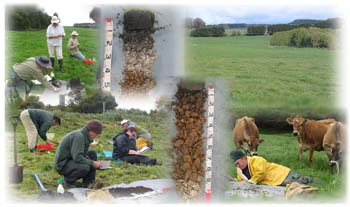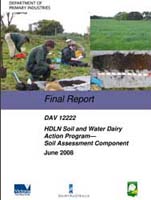HDLN Soil & Water Dairy Action Program - Soil Assessment Component June 2008
|
Introduction |  |
Summary of findings
The main findings from this soil health benchmarking project include:
- The soil physical conditions in the Heytesbury area during the monitoring period (2005–2007) were generally good, with little evidence of pugging.
- Pastures on soils with low pH and high aluminium levels could profitably respond to application of lime.
- Levels of soil phosphorus were high to very high (>25 mg/kg) at most monitoring sites. These levels are higher than the economic optimum for pastures and are potentially detrimental to the local environment. Farmers could reduce, or temporarily cease, their phosphorus applications and still maintain high pasture productivity, while saving costs.
- Where soil potassium levels are high, potassium inputs can be reduced or deleted from the fertiliser regime. High potassium levels are potentially a concern for farmers, as they are implicated in the occurrence of grass tetany (hypomagnesemia) in near-calving and lactating cows.
- Soil chemical testing was able to identify potential soil health risks which were not detected by visual assessments. In particular, the production and use of whole farm nutrient maps, as supported by the Heytesbury District Landcare Network, would assist farmers to identify and manage soil health issues on their property.
 | HDLN Soil and Water Dairy Action Program - Soil Assessment Component June 2008 (PDF - 1051 KB) HDLN Soil and Water Dairy Action Program - Soil Assessment Component June 2008 (DOC - 709 KB) To view the information PDF requires the use of a PDF reader. This can be installed for free from the Adobe website (external link). |


